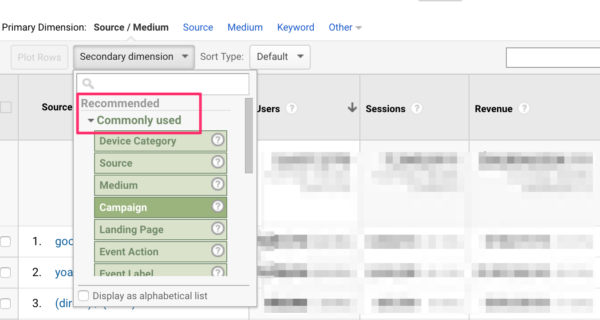Enhance Your SEO Campaigns with Secondary Dimensions: A Comprehensive Guide
Wiki Article
Transform Your Information Understanding With Secondary Measurements
Exploring information via the lens of second dimensions opens up a world of untapped insights, supplying a more nuanced perspective on the ins and outs of your dataset. By untangling the layers below the surface metrics, you can discover patterns and relationships that might have otherwise gone undetected, leading the way for informed decision-making and tactical optimizations. This critical use of additional dimensions not only improves your information understanding however also functions as a stimulant for opening the full potential of your analytics ventures.Advantages of Secondary Dimensions

Second dimensions likewise make it possible for companies to perform more comprehensive efficiency assessments. By layering additional measurements onto existing data, organizations can analyze the impact of different variables on essential metrics, assisting them make more educated choices. Secondary measurements facilitate the recognition of brand-new chances for optimization and growth by uncovering relationships that may have otherwise gone unnoticed. Overall, the utilization of additional measurements causes a lot more insightful and durable data evaluation, equipping services to drive strategic activities based upon a deeper understanding of their information.

How to Apply Secondary Dimensions
To effectively implement additional dimensions in information analysis, businesses must first identify crucial variables that align with their analytical goals and goals. This involves identifying the details metrics and measurements that are most pertinent to the insights they seek to get from the data. When these key variables are determined, businesses can then choose the suitable second dimensions to improve their analysis additionally. It is important to consider exactly how these second dimensions will supply additional context and deepness to the key information being examined.
Studying Information With Second Measurements
Utilizing second measurements in information analysis improves the deepness and context of understandings acquired from main information. By incorporating second measurements into your analysis, you can gain an extra extensive understanding of the relationships and patterns within your data. This process includes analyzing the primary data via different lenses or perspectives, which can disclose check over here covert correlations or trends that might not be right away noticeable when evaluating the information making use of only primary measurements.Assessing information with additional measurements enables you to section and group your information in different means, giving a much more nuanced view of your dataset. secondary dimensions. This segmentation can help you recognize details aspects that might be affecting the end results you are studying. By drilling down right into the information utilizing additional dimensions, you can uncover beneficial insights that can lead decision-making and method development
Ideal Practices for Secondary Measurements
When including secondary measurements into data analysis, precision in defining the measurements is essential for removing significant insights. It is vital to choose second measurements that match the key data successfully.An additional ideal method is to stay clear of redundancy in measurements. Ensure that the secondary dimensions include brand-new viewpoints or information to the evaluation, as opposed to replicating info already present in the primary measurements. This will certainly assist protect against confusion and enhance the interpretation of the information.
Additionally, it is very important to think about the scalability of the evaluation when selecting second measurements. Select dimensions that can be easily expanded view website or readjusted as required to accommodate future information needs or changes in analytical focus. By following these ideal methods, experts can make best use of the worth of additional dimensions in information evaluation and gain deeper understandings right into their datasets.
Maximizing Insights Via Additional Dimensions
Integrating additional measurements purposefully improves information evaluation by providing a much deeper understanding of the relationships within the dataset (secondary dimensions). By making best use of understandings with additional dimensions, experts can discover important patterns, trends, and reliances that might not be quickly noticeable when analyzing the data via main dimensions aloneOne trick advantage of making use of secondary measurements is the ability to sector and filter data much more specifically. This segmentation permits for a more granular analysis of specific subsets within the dataset, making it possible for experts to identify connections and causations that could have otherwise been ignored.
Furthermore, second dimensions can assist in contextualizing key data points by including layers of information that provide an even more comprehensive sight of the information. This contextualization is vital for making educated decisions based on an all natural understanding of the dataset.
Conclusion
To conclude, incorporating additional measurements in information evaluation processes provides a much more nuanced and detailed understanding of details, leading to improved insights and calculated decision-making. By incorporating added variables that align with analytical goals, hidden fads and relationships can be revealed, providing a much more in-depth and contextualized sight of try these out information. This strategy makes best use of the potential for optimization and uncovers new possibilities within procedures.Overall, the utilization of secondary dimensions leads to more durable and informative data analysis, empowering companies to drive tactical activities based on a much deeper understanding of their information.
Using additional dimensions in data evaluation boosts the deepness and context of insights obtained from primary data.Analyzing information with second measurements enables you to sector and team your data in numerous methods, giving a more nuanced sight of your dataset.When including additional dimensions right into data evaluation, precision in defining the dimensions is crucial for removing meaningful insights. Guarantee that the secondary measurements add brand-new viewpoints or information to the evaluation, instead than replicating information currently present in the primary measurements.
Report this wiki page